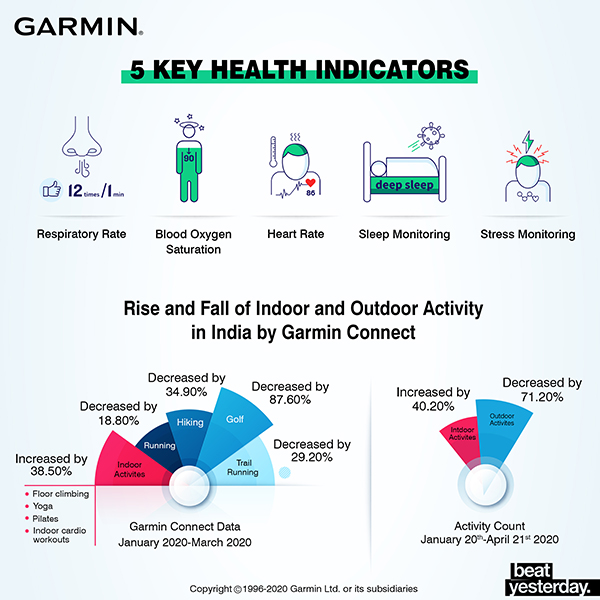Analyze your indoor workouts and manage your health with Garmin’s health monitoring data
With the current pandemic situation resulting in activity restrictions, staying healthy and fit has become a challenge. These sudden changes have brought about drastic lifestyle transformations, making it difficult to get into a routine. More than ever, it is critical for us to exercise regularly to boost our immunity.
With gyms, fitness centers and clubs closed, meditation and exercising at home have become the newfound routine for fitness enthusiasts across the nation. According to Garmin Connect data, from January to March 2020, the activity count for outdoor activities had an overall drop of 15.5 percent, with activity count for golf, hiking trail running and running decreasing by 87.6 percent, 34.9 percent, 29.2 percent and 18.8 percent respectively. In comparison, indoor activities such as floor climbing, yoga, Pilates and indoor cardio workouts showed an overall increase of 38.5 percent in the same period.
With travel and activity restrictions implemented from March 2020, overall outdoor activity count from January’20 till 21 April’ 2020 dropped by 71.2 percent while indoor activity count increased by 40.2 percent in the same period.
In light of the lifestyle changes, it is crucial to keep a consistent check on one’s physiological data to actively monitor physical health and wellbeing.
World Health Organization’s “Clinical management of severe acute respiratory infection (SARI) when COVID-19 disease is suspected” Interim Guidance[i] spotlights the importance of health monitoring data; one of the clinical syndromes is severe pneumonia where the patient may experience fever or suspected respiratory infection, plus respiratory rate of more than 30 breaths/min; severe respiratory distress; or SpO2 of less than 93 percent on room air.
Garmin smartwatches enable users to track their physiological data[ii], providing daily insights to their health status. Garmin India has identified five key health indicators to enable Garmin users to track and manage their health profile. Users should refer to data from their Garmin smartwatch with the five health indicators to identify any changes rather than depending solely on own assumptions to determine their own health status.
Garmin’s Five Health Indicators
· Heart Rate: The heart is the pilot of all body activities. The health status can be effectively monitored by analyzing your heart rates. It is generally believed that when the body temperature rises abnormally, the heart rate will increase; likewise, when the body temperature drops, the heart rate and strength of heart contractions will decrease accordingly. Those with a higher resting heart rate can indicate a higher risk of getting cardiovascular diseases. By doing regular exercises, the body’s sympathetic nervous activity decreases, which will lower the resting heart rate, improving the heart function and resulting in a more flexible neuromodulation.
· Respiratory Rate: Respiratory rate plays a critical role. The normal respiratory rate of a healthy adult is 12 – 20 breaths per minute (brpm). A low respiratory rate is a general indication of good health. Even while exercising, the respiratory rate of those with better physical fitness levels tend to be lower. There are many breathing techniques that can help you to manage your stress levels, relax and improve your concentration and sleep quality. Indulging in breathing exercises daily will help reduce the anxiety and stress and keep the health on track.
· Blood Oxygen Saturation: Blood oxygen saturation is closely related to lung health. Blood oxygen saturation (SpO2) refers to the concentration of oxygen in human blood, which is the key index to measure health. The ideal Spo2 level should be between 95 – 100 percent. A figure lower than 90 percent is considered too low, however, the figure may vary with individual physical differences. For instance, some people may feel discomfort at high altitudes because of the decrease in Spo2 levels. Monitoring how your body responds and changes with different blood oxygen saturation levels in different states can help you understand your own body better.
· Sleep Monitoring: Your immunity is the first line of defense against viruses. Quality sleep is the key to maintaining healthy body functions. When people go to sleep, they experience several cycles of rapid eye movement and non-rapid eye movement. The non-rapid eye movement stage can be further divided into deep and light sleep. During the deep-sleep stage, the body will begin to repair, build bones, grow muscles and enhance the immune system. In normal circumstances, a healthy adult will get approximately 15-25 percent of deep sleep each night. However, this figure varies amongst individuals. Garmin’s sleep monitoring function records the level of blood oxygen saturation and the number of times you toss and turn throughout the night so you can closely monitor your sleep quality.
· Stress Monitoring: The tenser a situation is, the more we will need to stabilize our physical and mental states. When we are caught up in highly stressful situations over long periods of time, our physical and mental health can get affected from coping with the stress and these responses could be destructive to our health over time. Garmin’s stress detection function uses Heart Rate Variability (HRV) to estimate the body’s stress levels. Training, physical activities, sleeping conditions, mental state and other daily activities will affect your stress levels. Garmin’s stress monitoring function measures stress levels from 0 to 100; 0-25 suggests a low stress level, 26-50 suggests a moderate stress level and 51-75 and 76-100 indicates high and extremely high stress levels respectively. This function will enable you to monitor your daily stress levels.










